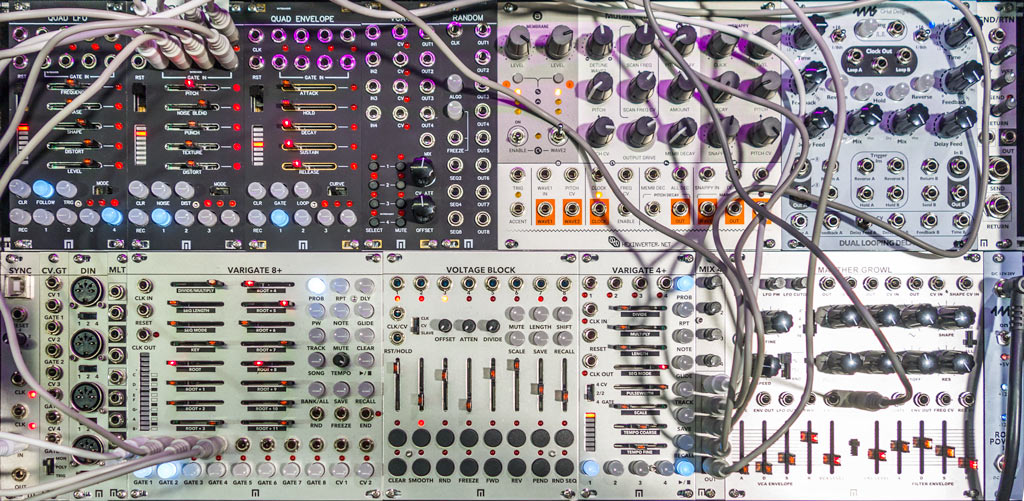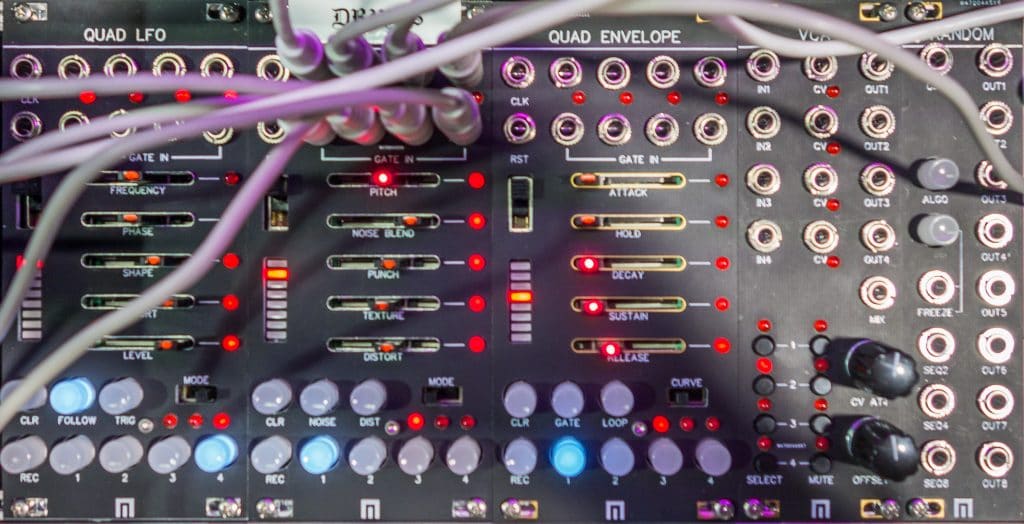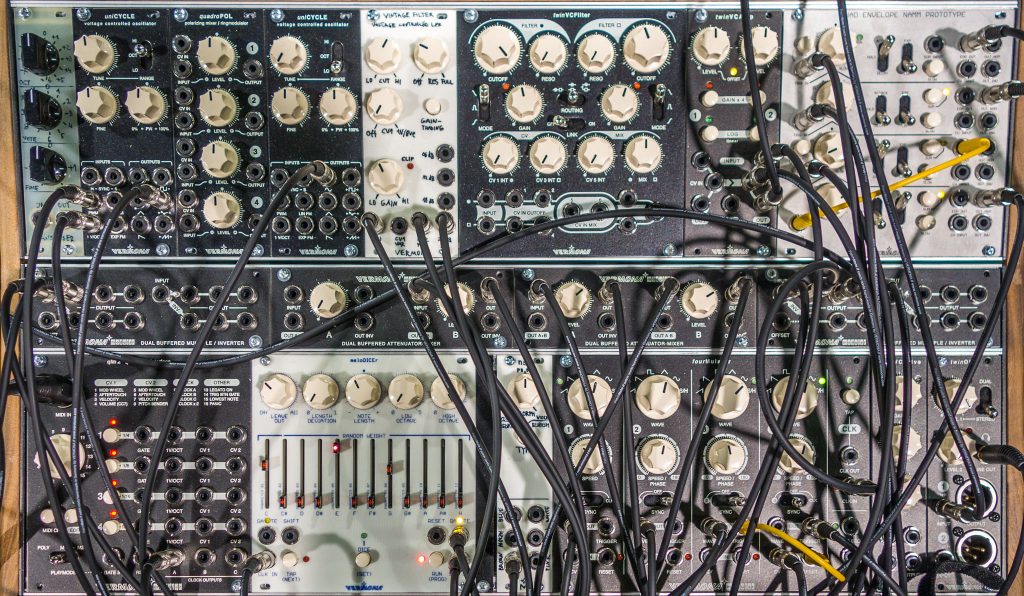It’s interesting to see what “themes” emerge during a NAMM show, where several manufacturers are looking at a particular area even though there was no previous coordination between them. A few of those themes this year included CEM 3340-based VCOs (as there are now two sources for this classic, previously-unavailable chip), granular synthesis, semi-modulars, and multiple voices.
I touched on that last one in the first installment, with 4ms’ Spherical Waveform Navigator being capable of 6-voice polyphony; in general, more companies are looking at configuring a modular to produce more than one sound at the same time – and we’ll look at a few of them here.
Doepfer Musikelektronik
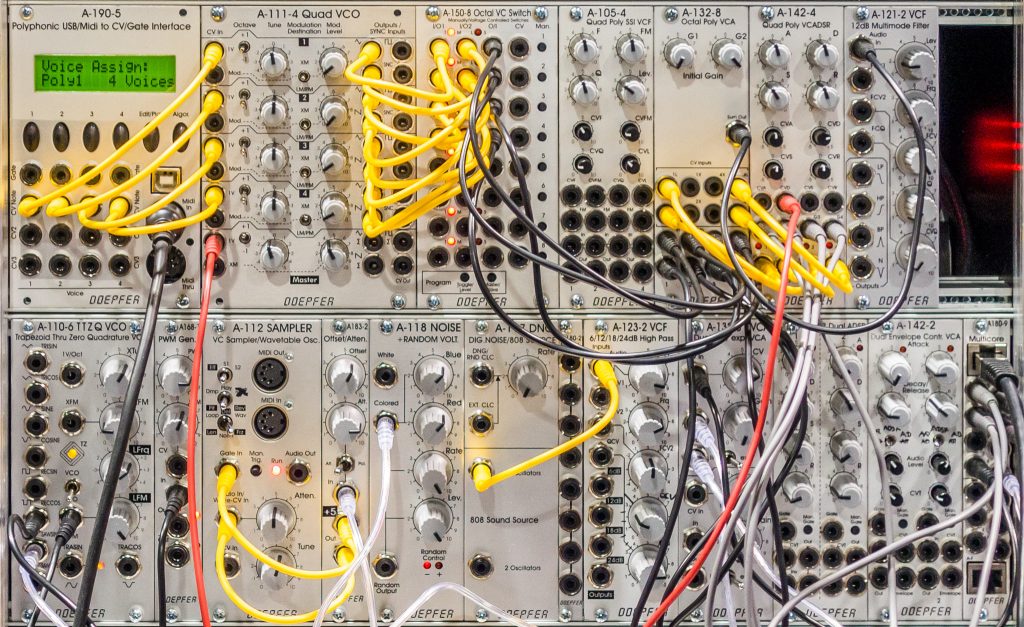
Dieter Doepfer himself was at NAMM, patiently demonstrating his new modules to create a four-voice polyphonic modular patch where one set of parameters could change all four voices at once. These modules included:
- A-190-5 Polyphonic MIDI to CV/Gate Interface (€300), providing pitch, gate, and two modulation CVs for each of four voices. It has both USB and 5-pin DIN connectors.
- A-111-4 Quad VCO (€400), which uses the re-issued 3340 VCO chips and supports either linear or exponential FM. A nice touch was the +/-1v switch next to the main 1v/oct to help get all four VCOs into the desired range for the controller you’re using.
- A-150-8 Octal VC Switch (€150), which provides eight sets of 2 in/1 out switches with manual or voltage control over which input is active. In the NAMM demo case, Doepfer had both the sawtooth and triangle waves for each section of the A-111-4 Quad VCO patched to four sections of the A-150-8 to make changing waveforms across a polyphonic voice easier.
- A-105-4 Quad VCF, which allows the actual filter to be swapped out via a card on the back. The “SSI” on the front panel of the NAMM unit makes me think it was using Sound Semiconductor’s SSI2144 update of the classic SSM2044 VCF chip.
- A-141-4 Quad Voltage Controlled ADSR (the prototype panel at NAMM said A-142-4, but that number’s already taken by their Quad Decay module). One set of CV inputs for the attack, decay, and release times as well as the sustain level are used for all four envelope generators in the module.
- A-132-8 Octal VCA. It will leave the factory set up four linear and four exponential VCAs, assuming you may want to use the linear VCAs connected to their logarithmic/exponential ADSR as your final stage, and the exponential VCAs to set audio levels for waveform mixing etc. There are jumpers on the back of the module to change how they behave, so you can make all 8 VCAs linear, for example. (By the way, this is trait many of Doepfer’s new modules shared: Whenever I asked Dieter for an alternative implementation of a feature, he had almost always already thought of it, and made it available on a jumper on the back of a module.)
If you’re thinking “four filters, four ADSRs and eight VCAs in 8hp each?!? I’m getting these for my compact system!” remember that they are set up so groups of four sub-modules are getting controlled by one set of control voltages or knobs; you don’t necessarily have independent voltage control over each sub-module. But if you’ve wanted to play real polyphony on your modular, these new modules (some of which are shipping now) will get you a long toward that goal.
Doepfer were also demonstrating a bunch of other new non-polyphonic modules, including:
- A-173-1/2 Micro Keyboard and Gate Modules (€180 for the set). This two-module set allows you to place a mini-keyboard in one place in your system, and then place the CV/gate output module somewhere else in your system. They are joined together with a simple two-wire cable connected to jumpers on the back, which sends MIDI messages from one to the other. It’s very flexible in that you can re-program some of the “keys” on the sending module to be just gates triggered on the output module – perhaps for sequencer start/stop, stepping through options on a sequential switch, etc.
- A-180-9 Multicore (€120 for a pair), which is sort of patchbay or patch block that allows you to send up to 14 different signals between different cases. A shielded Ethernet cable (included) is used to connect them together. This is a passive device, so you might get a slight drop in voltage for really long cable runs, but otherwise it should work fine for a variety of signals.
- A-123-2 VCF. A highpass filter with separate 1, 2, 3, and 4 pole (6, 12, 18, and 24 dB/oct) outputs, as well as voltage-controlled resonance.
- A-142-4 Dual Envelope Controlled VCA. The envelope section can be changed between a few different modes, including AD, AR, and ADSR. There’s one knob per VCA for Attack, and a second for Decay/Release (giving the old Minimoog style response); a jumper on the back sets whether the sustain level is 25% or 50% of full level.
- A-140-2 Dual Micro ADSR. This may be the best example of Doepfer’s approach of using jumpers on the back to change how the module works. There is one CVT input + attenuator for each ADSR, with “T” equalling Time. A jumper on the back sets if that time parameter is just Decay, Decay & Release, or Attack, Decay, & Release. A second jumper sets if the second output per side is inverted or not. This could be an excellent module for a small, “meat and potatoes” type system.
- A-138s Mini Stereo Mixer. A simple four in mono in, stereo out mixer with front panel controls for level and pan of each input (no voltage control).
Also notable is that these new modules follow the new standards for voltage levels that several manufacturers have recently agreed to: +/-5v for bipolar signals such as VCOs and LFOs; 0-10v for unipolar signals such as envelopes. I wrote a post about this for my Patreon subscribers; I’ve made it public now so you can see it too (and get a taste of the bonus content I create for my patrons).
Malekko Heavy Industry
Malekko has a different take on building a large modular system with multiple voices: each voice may be different, although they may all be coordinated by their Varigate and Voltage Block modular sequencer system. Most of the new modules Malekko showed at NAMM shared the Varigate’s clocks (so they could sync to divisions or multiples of the beat), as well as operating interface where there’s one set of controls plus a channel selector. They included:
- Quad LFO ($299), which includes the ability to set the phase per LFO section to get quadrature and other coordinated pulsations.
- Quad Envelope ($299), which features a Hold stage between Attack and Decay.
- Quad VCA ($199) with 4 individual inputs and outputs, CV on all independent channels, an additional mix output and mute switches.
- Drum ($349) four-channel drum synthesizer, with parameters such as Noise Blend, Punch, Texture, and Distort.
- Random ($169), a simple random signal generator with eight individual outputs and three sequenced outputs. It supports a variety of algorithms, as well as voltage controlled or manual freeze.
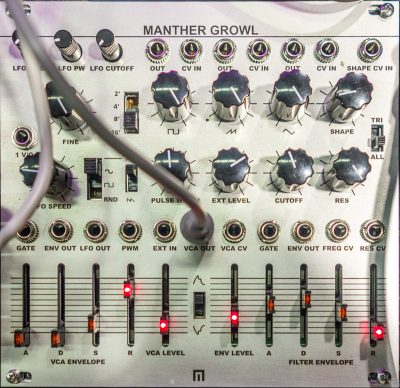
Malekko also introduced Malekko Growl ($499), a Eurorack semi-modular version of their Manther desktop synth without the sequencer and MIDI. It includes a CEM 3340 based VCO, SEM 2044 based VCF, and a Source Mixer that combines the Square, Triangle, Saw, Tri Shape, Noise and Sub signals.
Vermona Elektroakustische
A completely different take on a “quad” module is the Vermona quadEnvelope, which was previewed at Superbooth 17. Each of the four sections is a separate stage of the composite envelope (or envelopes) you are building). You can set a stage to be Attack, Hold, or Decay, choose its shape, and set its time from 500 microseconds to 30 seconds (this is also under voltage control). An “EOS” or End of Stage trigger can then be patched to start the next section. A summing section mixes the voltages of the various stages together to create the composite envelope. (They admit there could be some tiny glitches as these transitions, but they don’t expect it to be a problem.) This way, you can patch it to be an AD, an AHR, an AAD (a shape with a double attack before it decays), etc. For those who like to use slope generator modules to construct their own envelopes, the quadEnvelope is the next step; others users may not be as appreciative of its “assembly required” approach – especially at a projected price around $489.
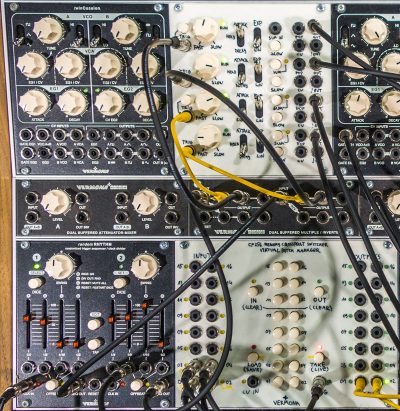
Vermona also has a new Memory Crosspoint Switcher where 16 inputs can be routed to any combination of 16 outputs, with presets. The connections and summing are accurate enough to use for pitch CVs. They refer to this module as a “virtual patch manager.” You can use a trigger to step between presets, or use a control voltage to select the next patch and then send a trigger to load it.
Finishing up with a “normal” module, Vermona also showed an aggressive-sounding Vintage Filter transistor ladder low pass filter based on the design inside their keyboard, the limited-production ’14 Analogsynthesizer. There are separate 1, 2, 3, and 4 pole (6, 12, 18, and 24 dB/oct) outputs like the new Doepfer highpass filter, as well as feedback for self-FM. There is also a gain compensation switch for higher resonance settings, where normal ladder filters typically lose a lot of bass.

